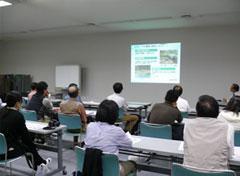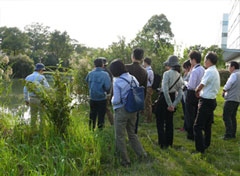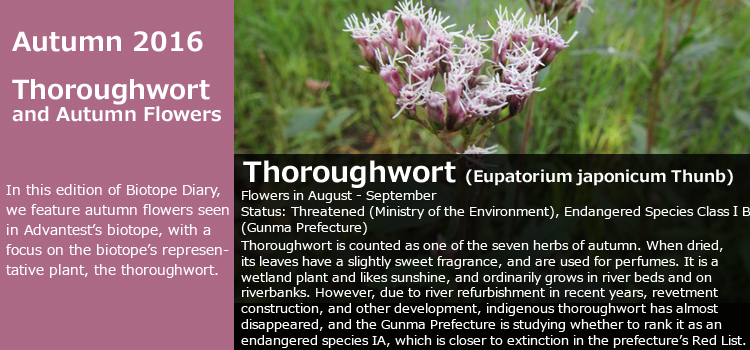
Thoroughwort in the Biotope
Our biotope is one of only four confirmed native habitats of thoroughwort in Gumma prefecture. It is thought that the seeds arrived via the Yatagawa River which flows about 100 m north of
the biotope. Thoroughwort is indigenous to the banks of the Yatagawa river. Originally it took root in the biotope spontaneously, but because there was a possibility that it would go extinct
in the biotope due to inbreeding weakness, we also transplanted some seedlings and cuttings from other local areas where thoroughwort grows.
In our biotope, we are currently working to improve the environment for thoroughwort, including securing enough sunshine for it. Mowing is a key issue. Thoroughwort relies on other grasses,
and sometimes it may end up entangled with invasive species we would want to eliminate, such as Canada goldenrod. In such a case we do not cut the grass with a lawnmower, but weed it by
hand, even in the scorching sun.
Stabilizing an endangered species is never easy, and we sometimes saw our thoroughwort plants decrease in number. However, about ten years have passed since it arrived at the biotope, and
recently it has become possible to confirm a certain number of individual plants in the places where it grows.
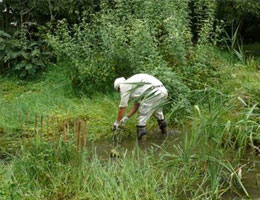
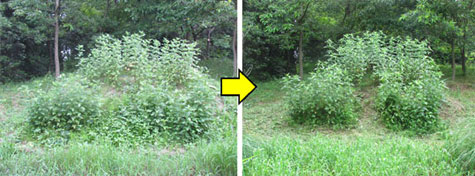
How Thoroughwort Grows
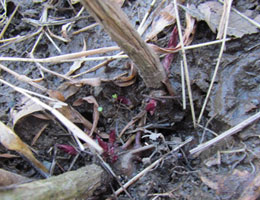
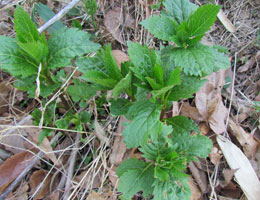
A small red sprout emerges from the rhizome around March. In April, lush sprigs appear.
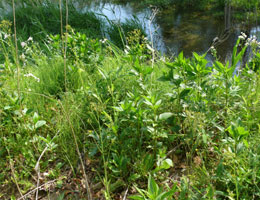
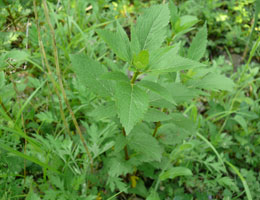
May sees sudden, energetic growth. Depending on the location, it may be difficult to distinguish thoroughwort from the other plants it grows among. The characteristic of thoroughwort is trefoil leaves. However, it seems that some naturally occurring plants do not clearly show this feature.
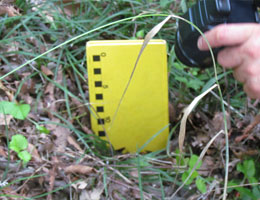
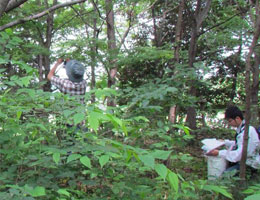
In order to understand the growing environment of thoroughwort, we collect various data including air temperature and soil temperature. The photo on the left shows measurement of the thickness of the leaf mold layer. On the right, a worker replaces a thermometer broken by a crow. At the moment we are attaching thorns to the thermometer to deter the crows from repeating this trick.
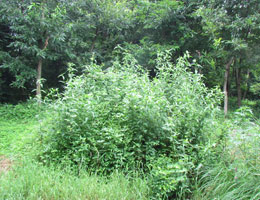
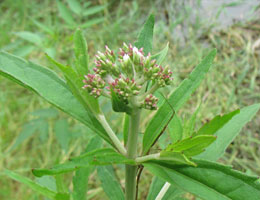
In July, thoroughwort grows taller as the weather gets hotter. Buds appear.
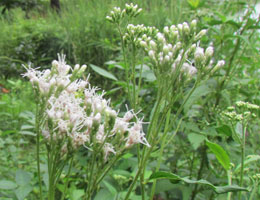
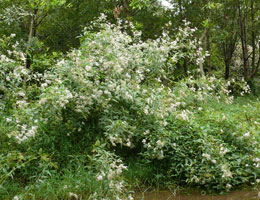
Flowers begin to bloom in August. Depending on location, some plants bloom more vigorously. If one does not bloom well, we will consider transplanting the plant to a sunny place. Thoroughwort comes into full bloom in September.
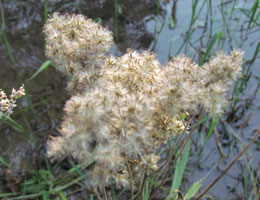
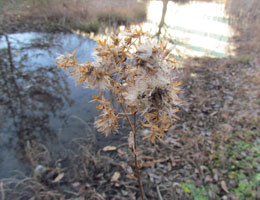
Flowering is almost finished in October, leaving behind seeds. In winter, the leaves and stems die, but thoroughwort is a perennial grass, so in the spring it will bud again from the rhizome hidden in the ground.
The Seven Herbs of Autumn in the Biotope
The traditional seven flowers of autumn in Japan are: Hagi, obana, kuzu, kawara nadeshiko, ominaeshi, fujibakama, and kikyo (Bush clover, Japanese pampas grass, kudzu, Dianthus superbus, Patrinia scabiosaefolia, thoroughwort, and Platycodon grandiflorus). While the "seven herbs of spring" are to be eaten, the seven herbs of autumn are just to be enjoyed for their beauty. (It may surprise American readers that kudzu is considered a attractive plant in its native habitat!)
In Advantest's biotope, you can see four of these flowers: Bush clover, Japanese pampas grass, kudzu, and thoroughwort. Dianthus superbus likes sunny river beds and grasslands, but it is not native to the biotope. Patrinia scabiosaefolia and Platycodon grandiflorus are on the Red Lists in Gumma Prefecture, where our biotope is located, and are designated as endangered species class II
- Bush clover
-
Scientific name: Lespedeza
Flowering period: August - October
It is a plant that can be seen throughout Japan. In general, plants of the legume family grow well even in poor soil. The stem becomes hard like a tree, but it grows year by year and a new sprout comes out from the root every year. Also, even in the same genus, "cat clover" has softer stems, and is classified as a grass.
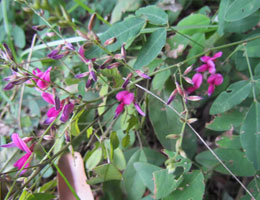
- Japanese pampas grass
-
Scientific name: Miscanthus sinensis
Flowers: September - October
It grows naturally in sunny places and is seen all over Japan. In some areas, there is a custom to offer pampas grass at temples at the festival of the harvest moon.
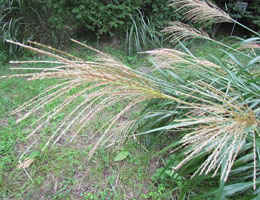
- Kudzu
-
Scientific name: Pueraria lobate
Flowers: July - September
Kuzu-mochi, Kuzukiri, Kuzuyu, Kakkon, etc. have been known as edible and medicinal products for a long time in Japan. Kudzu has an extraordinary power to regenerate itself from the rhizomes, even if you cut the vines. This has led to its classification as an invasive species in the US, where it is known as "The Vine That Ate the South." Even in the biotope, we cut it back when it gets out of hand.
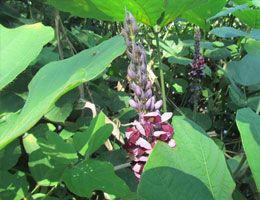
Other Autumn Flowers
Apart from the "seven herbs," the biotope also has other flowers unique to the autumn. Seasonal colors, legume-family plants, and asteraceae can be seen at this season.
- Akinonogeshi
-
Scientific name: Lactuca indica var. Indica
Flowers: August - November
In our biotope we have only confirmed a few of these plants. It is likely that it grows in the same place as the invasive species Canada goldenrod, and has been erroneously eradicated together with it. Its flowers are pale yellow, or rarely white or light purple. The flowers open at noon and close in the evening.
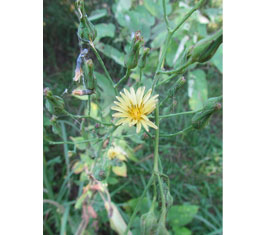
- Inu tobana
-
Scientific name: Clinopodium micranthus
Flowers: August - October
"Inu" seems to be a corruption of the word "ina" meaning something similar, and has no relation to dogs ("inu" in Japanese). While the tobana, to which it is related, blooms in early summer, dog tobana blooms from summer to autumn. It is said that it likes a somewhat moist place out of strong sunlight, and in our biotope it originally appeared in a sunny meadow, but we transplanted it into the shade to encourage its growth.
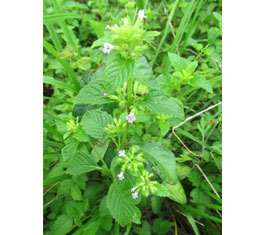
- Navy Chrysanthemum
-
Scientific name: Aster ageratoides var. Ovatus
Flowers: August - November
This is the typical "wild chrysanthemum" that you often see in the city. Although its name is "Navy chrysanthemum," its flowers are close to white as shown in the picture. It is said that they grow nicely in environments shaped by human hands, and in the biotope we see many of these along the paths after cutting the grass.
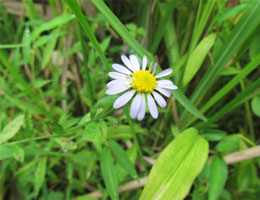
- Higambana
-
Scientific name: Lycoris radiata
Flowers: September
From summer to autumn, flower stems without leaves stretch out from the ground and flowers bloom. In winter, leaves appear in a rosette shape, but in spring they wither. Flowers and leaves never come out at the same time. The autogenous stock of Higambana in our biotope grows in the same position as the trees we planted around the pond, and we think their bulbs were contained in the root balls of the trees at the time of construction.
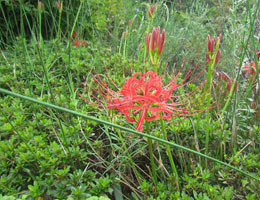
- Medohagi
-
Scientific name: Lespedeza cuneate
Flowers: September - October
From spring to summer it grows straight upwards, but in the autumn it bows down. Growing quickly in poor soil, because the root enters deep into the soil, it is used for landslide prevention and greening of slopes along road cuttings.
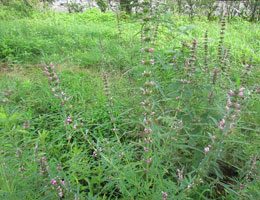
- Wild azuki beans
-
Scientific name: Vigna angularis var. nipponensis
Flowers: August - October
Wild azuki beans are vines, but cultivated azuki do not. Both their pods and beans are about half as large as cultivated azuki. It seems that you can eat the beans, but they are hard to harvest as when they ripen, the beans burst in the pod and are scattered to the ground.
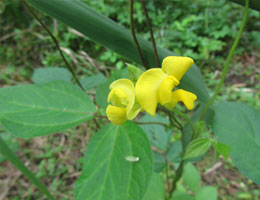
- Wormwood
-
Scientific name: Artemisia princeps
Flowers: September - December
Spring shoots are often eaten boiled and cooled made into tempura, or used as a flavor for rice cakes. Wormwood is seen everywhere in Japan and its extract, artemisin, is also known as an allelopathic substance that can be used as a cover crop to reduce weed growth.
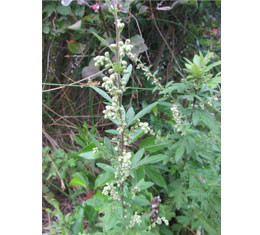
- Waremocou
-
Scientific name: Sanguisorba officinalis
Flowers: August - October
In autumn the stems grow tall, a rose-colored flower appears at the top of each stem, and it blooms from the tip to the bottom. It prefers open places such as grassland, and in our biotope it grows nicely in sunny places.
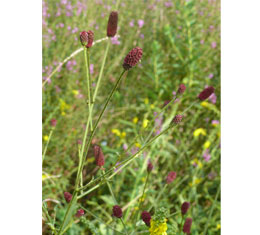
Nature Observation Classes at the Biotope
On July 14, we invited 33 second-graders from East Meiwa Elementary School in Gumma Prefecture to the biotope for a nature observation class.
Fishing for American crayfish, they did not catch as much as the children from West Meiwa Primary School did in June, but the children had great fun anyway, and caught a number of lake
prawns in their nets. After fishing, we strolled through the biotope forest and finally gathered insects in the field. Every time they caught a butterfly, a mantis, etc., the children
cheered in delight.
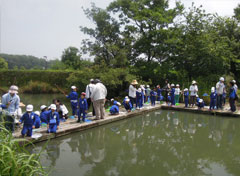
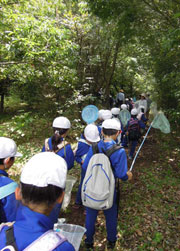
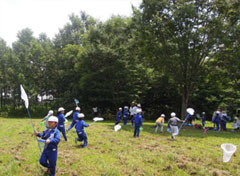
Biotope Tour for Corporate Environment Personnel
On October 7, 16 people from local corporations and affiliated with the Biodiversity Initiative (JBIB) visited our biotope.
JBIB is an organization of environmental personnel from about 50 member companies, who gather to conduct business such as study sessions and information dissemination to promote corporate
biodiversity initiatives. On the day of the tour, after a discussion and a field tour, we held a question-and-answer session centering on ecosystem-conscious management systems and our
ongoing monitoring since the foundation of the biotope. When we asked for feedback at the end of the tour, all the participants answered that the event was "helpful" or "very helpful".
